U.S. Department of Transportation
Federal Highway Administration
1200 New Jersey Avenue, SE
Washington, DC 20590
202-366-4000
Federal Highway Administration Research and Technology
Coordinating, Developing, and Delivering Highway Transportation Innovations
|
R&T NOW This newsletter is an archived publication and may contain dated technical, contact, and link information. |
|
| Publication Number: Date: January/February 2020 |
Publication Date: January/February 2020
|
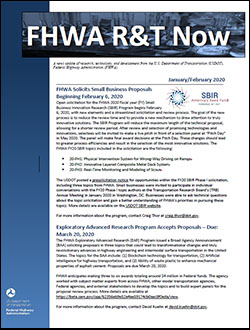
PDF files can be viewed with the Acrobat® Reader®
In this issue…

Open solicitation for the FHWA 2020 fiscal year (FY) Small Business Innovation Research (SBIR) Program begins February 6, 2020, with new elements and a streamlined solicitation and review process. The goal of the new process is to reduce the review time and to provide a new mechanism to draw attention to truly innovative solutions. The SBIR Program will reduce the maximum length of the technical proposal, allowing for a shorter review period. After review and selection of promising technologies and innovations, selectees will be invited to make a live pitch in front of a selection panel at "Pitch Day" in May 2020. The panel will make final award decisions at the Pitch Day. These changes should lead to greater process efficiencies and result in the selection of the most innovative solutions. The FHWA FY20 SBIR topics included in the solicitation are the following:
The USDOT posted a presolicitation notice for opportunities within the FY20 SBIR Phase I solicitation, including three topics from FHWA. Small businesses were invited to participate in individual conversations with the FY20 Phase I topic authors at the Transportation Research Board's (TRB) Annual Meeting in January 2020 in Washington, DC. Businesses were able to ask technical questions about the topic solicitation and gain a better understanding of FHWA's priorities in pursuing these topics. More details are available on the USDOT SBIR website.
For more information about the program, contact Craig Thor at craig.thor@dot.gov.
The FHWA Exploratory Advanced Research (EAR) Program issued a Broad Agency Announcement (BAA) soliciting proposals in three topics that could lead to transformational changes and truly revolutionary advances in highway engineering and intermodal surface transportation in the United States. The topics for the BAA include: (1) Blockchain technology for transportation, (2) Artificial intelligence for highway transportation, and (3) Ability of waste plastic to enhance mechanical properties of asphalt cement. Proposals are due March 20, 2020.
FHWA anticipates making three to six awards totaling around $4 million in Federal funds. The agency worked with subject matter experts from across FHWA, other modal transportation agencies, Federal agencies, and external stakeholders to develop the topics and to build expert panels for the proposal review process. More details are available at https://beta.sam.gov/opp/62356eb9e52a4ae59174cb0aac8f0eda/view.
For more information about the program, contact David Kuehn at david.kuehn@dot.gov.
In addition to using weather-responsive management strategies (WRMS) to manage flooding and predict and respond to dust storms, States can use WRMS to effectively manage burn scars after wildfires are contained. When burn scars happen, rainfall creates erosion, debris flows, or mudslides, resulting in extremely dangerous conditions for motorists.
The Utah Department of Transportation (UDOT) and the California Department of Transportation (Caltrans) have both used WRMS to successfully manage burn scars. Using a geographic information system map to indicate the location of burn scar boundaries, UDOT works with the Forest Service and National Weather Service (NWS) to determine rainfall rates for each burn scar area that would cause flooding and debris flows. NWS and UDOT use a dozen mobile weather stations to help monitor conditions in these areas.
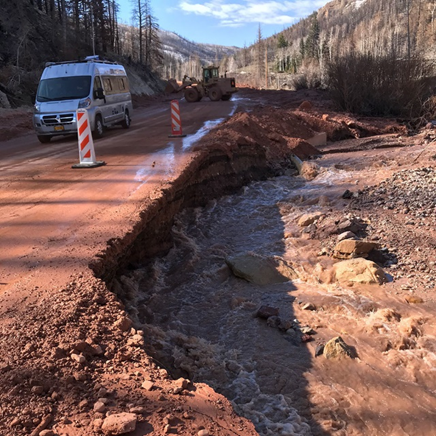
Source: UDOT.
After wildfires, roadways in burn scars are susceptible to damage from mudslides and debris flows.
Caltrans, in collaboration with the California Department of Forestry and Fire Protection, uses rainfall-rate briefings from the NWS to make better decisions for managing high-risk areas and shutting down highways prior to events occurring. This coordination and information allows Caltrans to take a proactive approach, resulting in an estimated $22 million in savings within the first year. The enhanced information also reduces the risk to travelers of any crashes or injury resulting from a debris flow.
Caltrans is expanding these efforts by using new road weather information systems (RWIS) to collaborate with the NWS to assemble forecast information for local agencies and law enforcement to proactively close highways when they predict mudslides and debris flows. The goal is to close roadways ahead of time, which allows roads to be cleaned faster and saves roads.
To learn more about how WRMS can help your agency respond to dangerous conditions created after wildfires or other unique weather events, contact David Johnson at david.johnson@dot.gov.
When emergency vehicles are involved in any situation, response time and travel time to the final destination is vital—and can make the difference between life and death.
At TRB's 2020 annual meeting, researchers from FHWA's Saxton Transportation Operations Laboratory presented an emergency-vehicle, signal-preemption application for installation on vehicles. The application allows for emergency vehicles to request that the lights at intersections along their routes change so that it is easier for the emergency vehicle to move through traffic in an emergency situation.
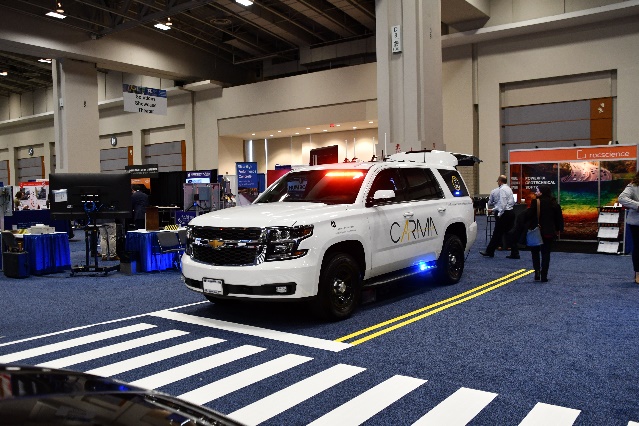
Source: FHWA.
FHWA's traffic-incident-management research vehicle displayed at TRB exhibiting emergency vehicle preemption.
Researchers created the application on the Vehicle-to-Everything Hub (V2X Hub) with a plugin that uses basic safety messages (BSMs) over dedicated short-range communications (DSRC).
When the emergency lights are activated inside the vehicle, the vehicle sends BSMs that tell the roadside unit (RSU), V2X Hub, and the signal controller of the request for the light change.
For demonstration purposes at TRB, the light turned red and then immediately started flashing yellow. In a real-life scenario, when an emergency-vehicle driver turns on the emergency lights, the traffic signals would turn red at the opposing intersection approaches, and the signal would turn green for the emergency vehicle to travel safely through the intersection.
For more information, contact Deborah Curtis at deborah.curtis@dot.gov.
Complex freeway interchanges can be difficult to navigate for drivers and they rely on road signage to guide them. Transportation agencies are urgently in need of detailed and performance-based guidelines for guide-sign design at freeway interchanges.
The Office of Safety Research and Development (R&D) will award a project to the Virginia Tech Transportation Institute (VTTI) for "Freeway Guide Sign Performance at Complex Interchanges: Reducing Information Overload." This new 24-month project will be conducted through the Naturalistic Driving Study (NDS) Pooled Fund program and will enable researchers to apply the Strategic Highway Research Program 2 (SHRP2) safety data resource in innovative ways.
Previous studies of sign performance at interchanges have limited applicability because they are based mostly on simulations and laboratory tests, and involve limited sign scenarios and field data due to data availability and cost.
Previous studies also involved only participants with either no destination or hypothetical destinations during experiments. They could not realistically incorporate traffic, environmental, and roadway conditions or link sign scenarios with quantitative driver-behavior measures relevant to safety.
This new study will fully demonstrate the SHRP2 NDS data's power to solve problems. The study will provide guidelines to reduce information overload and improve sign spreading and recommendations for changes to existing freeway-signing standards and manuals.
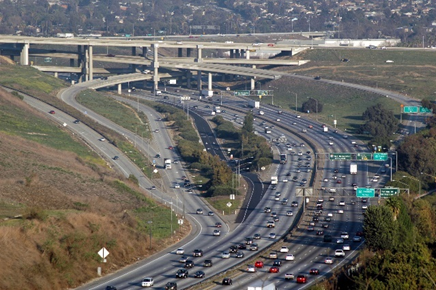
© VTTI.
Complex interchange between IH 10 and Highway 57 (Orange Freeway) in Los Angeles County, CA.
The findings of this project will provide practical and field data-supported, sign-performance metrics at complex freeway interchanges that may significantly improve existing signing guidelines and tools.
For more information, contact James Pol at james.pol@dot.gov.
Experts from across the transportation industry continue to identify the roughness experienced at bridge approaches, termed the bump at the end of the bridge (BEB), as one of the most prevalent substructure factors affecting bridge performance.
BEB is usually reported by road users, and is followed by maintenance to improve ride quality. BEB is not just an annoyance for the traveling public though; vehicle impact resulting from the bump can cause distress, fatigue, and long-term damage to the bridge deck, potentially resulting in decreased service life.
The FHWA Geotechnical Research Program is identifying methods to improve ride quality and the bumps at bridge approaches using inertial profilers. Pavement profilers are not new to transportation agencies, who routinely use them to evaluate pavement performance.
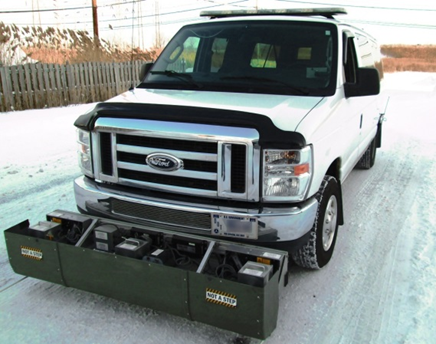
Source: FHWA.
Inertial profiler used to collect bridge approach profiles.
In 2016, the Long-Term Pavement Performance Program released guidelines for measuring bridge approach transitions using inertial profilers. Research is currently underway to evaluate these pavement profiles and the resulting BEB.
Long-term objectives of this research effort include developing performance metrics for the BEB, evaluating the impact on long-term bridge performance, and identifying mitigation measures to prevent or alleviate the BEB.
For more information, contact Dr. Jennifer Nicks at 202–493–3075, or jennifer.nicks@dot.gov.
How can a construction engineer minimize risk in project delivery and increase the likelihood that the project will be of high quality and on track?
Construction specifications provide the requirements for construction on a project to help achieve a higher level of confidence in accepting quality materials with higher performance, longer life, and reduced lifecycle costs.
FHWA recently released the second in a series of three animated videos focused on specifications for highway construction to help improve quality. The first video, Types and Uses of Construction Specifications, introduces viewers to various types of specifications, including quality assurance specifications, warranty specifications, performance-based specifications, and performance-related specifications.
The second video, Quality Assurance Specifications, covers how quality assurance specifications work, and highlights key aspects of a well-written quality assurance specification.
The third video in the series currently is in production.
Transportation agencies may want to consider using these videos as stand-alone training or within a broader training course. The videos, which can also be shared via social media, are available on the FHWA YouTube channel.
Video 1: Types and Uses of Construction Specifications
https://youtu.be/-FfOUfIbfF4
Video 2: Quality Assurance
Specifications
https://youtu.be/VeicnhCzn2A
For more information, contact Matthew Corrigan at 202–493–3365, or matthew.corrigan@dot.gov.
The FHWA EAR Program provides opportunities for post doctoral research associates to conduct cutting-edge research studies.
Working with the National Academy of Sciences' (formerly the National Research Council's (NRC)) Research Associateship Program (RAP), FHWA is looking for researchers with appropriate backgrounds to investigate specific problems on a short-term basis (up to 3 years) across a range of topics and disciplines.
"The RAP has provided me with the opportunity to work with an experienced team at Turner-Fairbank Highway Research Center [TFHRC] to investigate ultra-high performance concrete [UHPC] structural performance and develop design guideline specifications," said Dr. Alireza Mohebbi, one of the researchers in the program.
The RAP program accepts applications on a continual basis and the agency reviews the applications every quarter to see if there is a good fit between an associate and one of FHWA's researchers.
See the latest summary about research conducted by the research associates at FHWA in the Research Associates Program 2018 (FHWA-HRT-18-061).
More information about the RAP is available here or by contacting Jim Shurbutt at 202‒493‒3420, jim.shurbutt@dot.gov.
State agencies always look for ways to extend the life of pavement and bridges so their budgets go further. One particular concrete can help.
"Ultra-high performance concrete (UHPC) has been identified as a novel solution that not only can expedite the repair and construction process, but also can increase the service life of the bridge elements," said EAR research associate Dr. Alireza Mohebbi. "In addition, the structural performance and long-term durability of bridge elements with UHPC far exceeds those of conventional concrete. UHPC provides the opportunity to build long-span bridges with refined cross sections and possibly reduces the number of substructure systems required for multi-span bridges."
Mohebbi works in both the structural and concrete laboratories at FHWA's TFHRC. His project, Development and Evaluation of Innovative Structural Systems with UHPC and Resilient Connections: From Analyses and Experiments to Design Guidelines, addresses major challenges facing our Nation's crumbling bridge infrastructure.
For more information, contact Alireza Mohebbi at 202‒493‒3073 or alireza.mohebbi.ctr@dot.gov.
Before vehicles can safely drive themselves, they need to understand their surroundings and the complexities of their operation within those surroundings. The road. Other vehicles. Pedestrians. Bicylces. Weather. Unexpected circumstances. And more....
The FHWA EAR Program supports two connected simulation research projects to help solve safety issues with using connected and automated vehicle (CAV) technology. The projects involve complex scenarios incorporating vehicles, pedestrians, and bicyclists. The research places multiple people in the same simulated environment at the same time. Connected simulation allows for safe and more cost-effective testing of CAV technology.
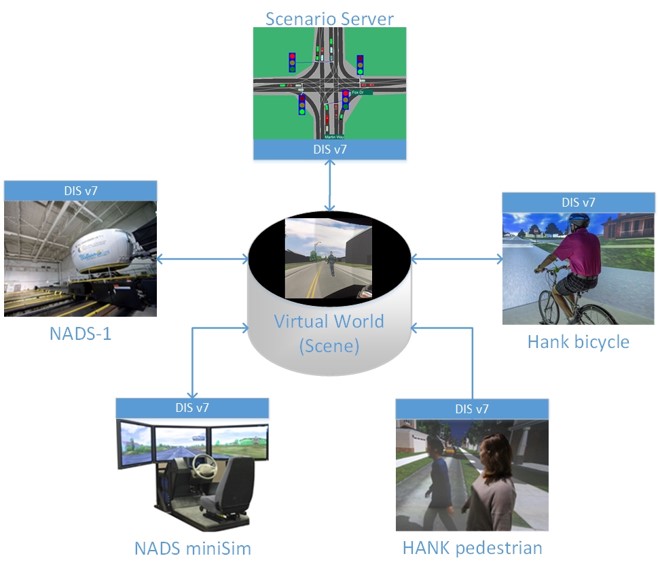
© University of Iowa.
University of Iowa researchers are connecting NADS with pedestrian and bicycle simulators to allow simulation participants to share the same virtual world.
Researchers at the University of Iowa are connecting the National Advanced Driving Simulator (NADS) with pedestrian and bicycle simulators, allowing them to simulate multiple modes of transportation in real time. The project, Developing Connected Simulation to Study Interactions Between Drivers, Pedestrians, and Bicyclists, includes the use of graphical avatars in the simulation to represent the live movements of drivers, bicyclists, and pedestrians.
Researchers at Iowa State University's Virtual Reality Applications Center and the Institute for Transportation are developing a system that lets multiple simulation systems work together. Their research project, InterchangeSE: A Federated Multimodal Simulation Environment for Studying Interactions Between Different Modes of Travel, allows for traffic with a mix of different vehicles—some highly automated and some with drivers controlling speed and direction—within one simulation.
Iowa State's researchers are studying the interactions among different travelers in a partially connected-automated transportation system using complex simulated scenarios with live and virtual participants. This project integrates virtual and augmented reality technologies with communications between hardware and software components.
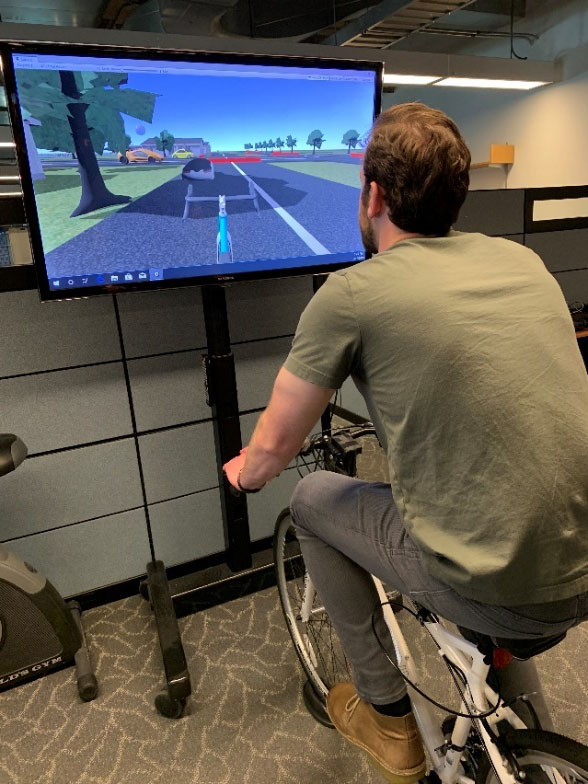
© University of Iowa.
At Iowa State University, researchers have created InterchangeSE, which allows simulation participants working on different platforms to see each other.
For more information about the Connected Simulation and InterchangeSE projects, contact Brian Philips at 202–493–3468 or brian.philips@dot.gov.
As part of the Highway Safety Information Team (HSIS), Safety R&D researchers, Drs. Ana Maria Eigen and Carol Tan, received the TRB Highway Safety Performance Committee (ANB25) "2019 Ronald C. Pfefer Outstanding Paper Award." The paper, Identification of Critical Intersection Angle Through Crash Modification Functions, described the process to develop the "CMFunctions" that could help identify intersection angles that have higher crashes. The paper awardees are as follow:
EAR Research Associateship Program Highlights: Where Are They Now?
Innovator January/February 2020
In this issue: Innovation Synergy: Crowdsourcing Improves Weather Response; Weather-Responsive Management Strategies; Filling in Data Gaps with Crowdsourcing; The Value of Peers; Using Accelerated Bridge Construction in Seismic Applications; States Innovate;
Explore Innovation at the Transportation Research Board Meeting.
The issue is available online.
Public Roads Winter 2020
This issue includes: Reaching New Heights; Coming Back from Disaster; Mainstreaming
Transportation Systems Management and Operations; Showcasing Highway Research;
What Does the Changing Face of Electricity Production Mean for Concrete?;
CARMA: Driving Innovation; Saluting 50 Years of Transportation Training.
For more information, contact Maria Romstedt at maria.romstedt@dot.gov.
Turner-Fairbank Highway Research Center:
https://highways.dot.gov/research/
Resource Center:
www.fhwa.dot.gov/resourcecenter/
National Highway Institute:
www.nhi.fhwa.dot.gov/home.aspx
FHWA R&T Now is a newsletter containing information and updates about research, technology, and development from the U.S. Department of Transportation, Federal Highway Administration. The newsletter is an electronic newsletter and is updated approximately every other month. Send your comments, questions, suggestions, and feedback to FHWA_Now@dot.gov.
Online access:
https://www.fhwa.dot.gov/publications/rtnow/.
Please forward this newsletter to others you think might find it interesting and/or useful.
Send your comments, questions, and feedback to FHWA_Now@dot.gov.
Mail:
Federal Highway Administration
FHWA Office of Research, Development, and Technology
Attention: R&T Now Managing Editor
6300 Georgetown Pike
McLean, VA 22101
Distribution–FHWA R&T Now is being distributed according to a standard distribution. Direct distribution is being made to the FHWA Divisions and Resource Center.
Key Words–Infrastructure, Operations, Safety, Research, SBIR, TRB, vehicle-to-everything, weather-responsive management systems, research associates program, UHPC, awards, EAR, SHRP2, connected vehicles, automated vehicles, connected and automated vehicles, automated driving systems, complex freeway interchanges, profilers, bridge bumps, National Advanced Driving, Simulator, CAV, AV, CV, specifications.
Notice–This document is disseminated under the sponsorship of the U.S. Department of Transportation in the interest of information exchange. The U.S. Government assumes no liability for the use of the information contained in this document. The U.S. Government does not endorse products or manufacturers. Trademarks or manufacturers’ names appear in this document only because they are considered essential to the objective of the document.